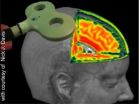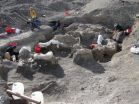(Press-News.org) Researchers from the University of Liverpool in collaboration with Public Health England have been investigating new ways to identify drugs that could be used to treat Ebola virus infection.
Their approach has been to study what proteins inside a cell are critical for the functions of Ebola virus and are hijacked by the virus to help with infection. One of the proteins they have targeted is known as VP24. This protein disrupts signalling in infected human cells and disrupts the body's immune system and the fight against the virus.
Once the team identified these cellular proteins they were able to find out whether any drugs were already in existence that could block the function of the particular protein. One such drug identified was ouabain, which can be used in the treatment of heart of disease. Administering this drug reduced virus replication in treated cells.
The study was led by Professor Julian Hiscox from the University of Liverpool's Institute of Infection and Global Health and Prof. Roger Hewson at Public Health England. Prof. Hiscox said: "This study shows how existing therapeutics can be identified and potentially repurposed for anti-viral therapy, and the technique of using existing and tested drugs for a different purpose can save considerable time and, ultimately lives."
Disrupting cellular proteins important for viruses also has the potential to tackle the problem of resistance to medication. Since the cellular proteins are effectively evolutionarily static, the virus won't be able to adapt to defeat it – as is increasingly the case with treatment by anti-virals used against viral proteins such as seen with influenza virus and HIV infection.
The study, which also involved Dr. David Matthews from the University of Bristol, was a collaboration with Public Health England and used the unique specialist facilities at PHE Porton, which are designed to safely work with viruses such as Ebola under conditions of high containment.
Co-author Professor Miles Carroll, Head of Research at PHE Porton, said: "This research highlights the anti-viral effects of an already available and licensed human drug which might prove beneficial in a therapeutic setting."
Professor Hiscox concluded: "The philosophy of transiently targeting the function of host cell proteins that are critical for virus infection holds great promise not only for increasing the potential arsenal of drugs against Ebola but other viruses as well."
INFORMATION:
The paper 'Elucidation of the Ebola virus VP24 cellular interactome and disruption
of virus biology through targeted inhibition of host cell protein function', was a collaboration between the University of Liverpool, Public Health England, the University of Bristol and the Health Protection Research Unit in Emerging and Zoonotic Infections. It is published in the Journal of Proteome Research.
Finding new approaches for therapeutics against Ebola virus
2014-09-04
ELSE PRESS RELEASES FROM THIS DATE:
Bats change strategy when food is scarce
2014-09-04
Echolocating bats have historically been classified into two groups: 'loud' aerial hawkers who catch flying insects on the wing and 'whispering' gleaners that pick up prey from the ground. While some bat species can forage in multiple ways, others have limited flexibility in the amplitude of their echolocation calls.
Dr Talya Hackett and colleagues studied the desert long-eared bat (Otonycteris hemprichii), said to be a passive 'whispering' gleaner that picks up ground-dwelling invertebrates, such as scorpions, from the desert floor.
Using an acoustic tracking system, ...
Visualising plastic changes to the brain
2014-09-04
Tinnitus, migraine, epilepsy, depression, schizophrenia, Alzheimer's: all these are examples of diseases with neurological causes, the treatment and study of which is more and more frequently being carried out by means of magnetic stimulation of the brain. However, the method's precise mechanisms of action have not, as yet, been fully understood. The work group headed by PD Dr Dirk Jancke from the Institut für Neuroinformatik was the first to succeed in illustrating the neuronal effects of this treatment method with high-res images.
Painless Therapy
Transcranial magnetic ...
Harvard & Cornell researchers develop untethered, autonomous soft robot
2014-09-04
New Rochelle, NY, September 4, 2014--Imagine a non-rigid, shape-changing robot that walks on four "legs," can operate without the constraints of a tether, and can function in a snowstorm, move through puddles of water, and even withstand limited exposure to flames. Harvard advanced materials chemist George Whitesides, PhD and colleagues describe the mobile, autonomous robot they have created in Soft Robotics, a peer-reviewed journal from Mary Ann Liebert, Inc., publishers. The article is available on the Soft Robotics website.
In "A Resilient, Untethered Soft Robot," ...
Intestinal barrier damage in multiple sclerosis
2014-09-04
Researchers at Lund University have published new research findings on the role of the intestinal barrier in the autoimmune disease multiple sclerosis (MS).
Within medical science, it is not known for certain how MS develops or why the body's immune system attacks cells in the central nervous system. Inflammation develops for an unknown reason, which hinders transport of neural impulses. This can produce various physical and mental symptoms, including a loss of sensation, motor difficulties, blurred vision, dizziness and tiredness.
The present study investigates whether ...
Moscow Institute of Physics and Technology specialists studied jet fuel ignition
2014-09-04
Researchers from Moscow Institute of Physics and Technology, Viktor Zhukov, Vladislav Sechenov and Andrei Starikovsky, have published experimental data on the combustion of jet fuel in the journal Fuel. The results of their research are important for simulating processes in jet engines.
In their paper, the scientists described how quickly a mixture of jet fuel and oxygen ignites depending on different conditions. This value, called the induction period or combustion delay period, was defined for different temperatures, pressure values and blending ratios. The data obtained ...
Should scientists handle retractions differently?
2014-09-04
It is one of the highest-profile cases of scientific fraud in memory: In 2005, South Korean researcher Woo-Suk Hwang and colleagues made international news by claiming that they had produced embryonic stem cells from a cloned human embryo using nuclear transfer. But within a year, the work had been debunked, soon followed by findings of fraud. South Korea put a moratorium on stem-cell research funding. Some scientists abandoned or reduced their work in the field.
But the case is not so simple: By 2007, other stem-cell researchers had found that the debunked research ...
Students report greater learning gains in traditional science courses
2014-09-04
Students taking traditional, in-class science courses reported higher perceived learning gains than students enrolled in online distance education science courses. Notably, African-American students taking traditional science courses self-reported greater affective and psychomotor learning gains than students taking online science courses.
These are the key findings of a new study co-authored by a Clemson University researcher and published in the most recent issue of Black History Bulletin.
The purpose of the study, funded by a grant from the National Science Foundation ...
Drexel team unveils Dreadnoughtus: A gigantic, exceptionally complete sauropod dinosaur
2014-09-04
This news release is available in Spanish.
PHILADELPHIA (September 4, 2014) – Scientists have discovered and described a new supermassive dinosaur species with the most complete skeleton ever found of its type. At 85 feet (26 m) long and weighing about 65 tons (59,300 kg) in life, Dreadnoughtus schrani is the largest land animal for which a body mass can be accurately calculated. Its skeleton is exceptionally complete, with over 70 percent of the bones, excluding the head, represented. Because all previously discovered supermassive dinosaurs are known only from relatively ...
Phase III FIRST™ (MM-020/IFM 07-01) trial of REVLIMID® (lenalidomide) plus dexamethasone in newly diagnosed multiple myeloma patients who are not candidates for stem cell transplant published in New E
2014-09-04
SUMMIT, N.J. (Sept. 4, 2014) – Celgene Corporation (NASDAQ:CELG) today announced that data from FIRST (MM-020/IFM 07-01)—an open-label phase III randomized study of continuous REVLIMID (lenalidomide) in combination with dexamethasone in patients newly diagnosed with multiple myeloma (NDMM) who are not candidates for stem cell transplant—have been published in the Sept. 4 issue of the New England Journal of Medicine.
Initial findings, including that the trial had met its primary endpoint of progression free survival (PFS), were reported during the plenary session at the ...
Nano-pea pod model widens electronics applications
2014-09-04
New York | Heidelberg, 4 September 2014 -- Periodic chain-like nanostructures are widely used in nanoelectronics. Typically, chain elements include the likes of quantum rings, quantum dots, or quantum graphs. Such a structure enables electrons to move along the chain, in theory, indefinitely. The trouble is that some applications require localised electrons—these are no longer in a continuous energy spectrum but in a discrete energy spectrum, instead. Now, a new study by Russian scientists identifies ways of disturbing the periodicity of a model nanostructure to obtain ...


